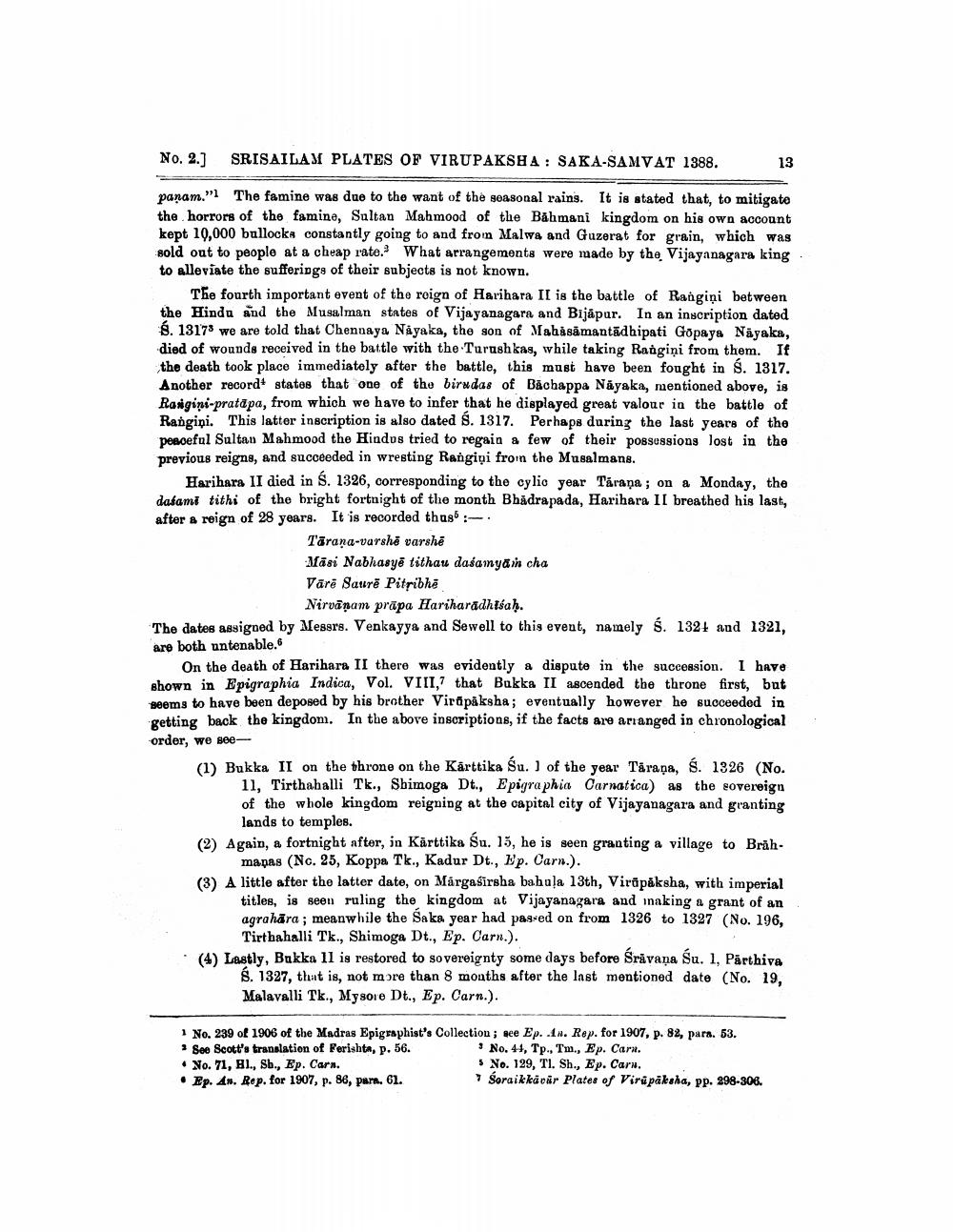________________
No. 2.]
SRISAILAM PLATES OF VIRUPAKSHA: SAKA-SAMVAT 1388.
panam." The famine was due to the want of the seasonal rains. It is stated that, to mitigate the horrors of the famine, Sultan Mahmood of the Bahmani kingdom on his own account kept 10,000 bullocks constantly going to and from Malwa and Guzerat for grain, which was sold out to people at a cheap rate. What arrangements were made by the Vijayanagara king to alleviate the sufferings of their subjects is not known.
The fourth important event of the reign of Harihara II is the battle of Rangini between the Hindu and the Musalman states of Vijayanagara and Bijapur. In an inscription dated 8. 13173 we are told that Chennaya Nayaka, the son of Mahasamantadhipati Gopaya Nayaka, died of wounds received in the battle with the Turushkas, while taking Rangini from them. If the death took place immediately after the battle, this must have been fought in S. 1317. Another record states that one of the biradas of Bachappa Nayaka, mentioned above, is Rangini-pratapa, from which we have to infer that he displayed great valour in the battle of Rangini. This latter inscription is also dated §. 1317. Perhaps during the last years of the peaceful Sultan Mahmood the Hindus tried to regain a few of their possessions lost in the previous reigns, and succeeded in wresting Rangini from the Musalmans.
Harihara II died in S. 1326, corresponding to the cylic year Tarana; on a Monday, the dasami tithi of the bright fortnight of the month Bhadrapada, Harihara II breathed his last, after a reign of 28 years. It is recorded thus:
Tāraṇa-varshē varshē
Masi Nabhasye tithau dasamyam cha
Vārē Saurē Pitribhē
13
Nirvanam prapa Hariharadhiśaḥ.
The dates assigned by Messrs. Venkayya and Sewell to this event, namely Ś. 1324 and 1321, are both untenable.
On the death of Harihara II there was evidently a dispute in the succession. I have shown in Epigraphia Indica, Vol. VIII, that Bukka II ascended the throne first, but seems to have been deposed by his brother Virupaksha; eventually however he succeeded in getting back the kingdom. In the above inscriptions, if the facts are arranged in chronological order, we see
(1) Bukka II on the throne on the Karttika Su. 1 of the year Tarana, S. 1326 (No. 11, Tirthahalli Tk., Shimoga Dt., Epigraphia Carnatica) as the sovereign of the whole kingdom reigning at the capital city of Vijayanagara and granting lands to temples.
(2) Again, a fortnight after, in Kärttika Su. 15, he is seen granting a village to Brahmapas (No. 25, Koppa Tk., Kadur Dt., Ep. Carn.).
(3) A little after the latter date, on Margasirsha bahula 13th, Virupaksha, with imperial titles, is seen ruling the kingdom at Vijayanagara and making a grant of an agrahara; meanwhile the Saka year had passed on from 1326 to 1327 (No. 196, Tirthahalli Tk., Shimoga Dt., Ep. Carn.).
(4) Lastly, Bukka 11 is restored to sovereignty some days before Śrāvana Su. 1, Parthiva Ś. 1327, that is, not more than 8 months after the last mentioned date (No. 19, Malavalli Tk., Mysore Dt., Ep. Carn.).
1 No. 239 of 1906 of the Madras Epigraphist's
2 See Scott's translation of Ferishta, p. 56. No. 71, Hl., Sb., Ep. Carn.
Ep. An. Rep. for 1907, p. 86, para. 61.
Collection; see Ep. 1n. Rep. for 1907, p. 82, para. 53. No. 44, Tp., Tm., Ep. Cara.
5 No. 129, Tl. Sh., Ep. Carn.
Soraikkäeür Plates of Virupaksha, pp. 298-306.




